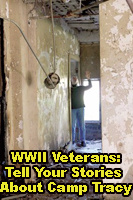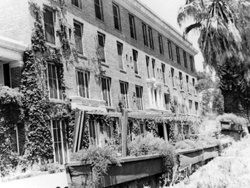 Veterans needed who recall stories of Camp Tracy, a top-secret WWII interrogation center
Veterans needed who recall stories of Camp Tracy, a top-secret WWII interrogation center
by Rick Lemyre
Left, Historian Carol A. Jensen shows remnants of soundproofing and bugging wires while guiding a tour of the Byron Hot Springs Resort for National Park Service researchers. Information is being collected on the resort’s use as a WWII prisoner interrogation center.
To some, it’s a crumbling edifice primarily useful for scrawling with graffiti and occasionally torching. To others, it’s a reminder of the area’s past glory as a vacation destination for the rich and famous. And to some, its potential for rebirth is one of the brightest spots on the far East County horizon.
No matter what Byron Hot Springs means to some people, its meaning is altogether different for others, a select group of individuals who, until lately, have kept their secrets to themselves. For them, and the historians now trying to collect their stories, the once-and-future mineral springs resort is known as Camp Tracy, a top-secret WWII interrogation center and one of only two such facilities in the country.
Vincent Santucci, chief ranger for the National Park Service’s George Washington Parkway in Virginia, is one of the latter. Santucci has been researching Virginia’s Ft. Hunt, clandestinely known as “P.O. Box 1142” after its postal designation, for years. Ft. Hunt, the other top-secret center dedicated to wresting secrets from high-level officers, scientists and political prisoners captured during the war, was meant primarily for Germans and Italians; Camp Tracy was intended for Japanese…
Ft. Hunt was virtually eradicated after the war, leaving researchers to rely on the sometimes hazy memories of a fast-dwindling core of veterans to learn what happened there. Many of Camp Tracy’s structures, on the other hand, still stand, tattered though they are.
“Most of 1142 is now gone,” Santucci said in a phone interview last week. “We very much envy the fact that Camp Tracy still has the original buildings.” Santucci and a contingent of other historians recently toured the East County site, accompanied by local historians Carol Jensen and Kathy Leighton. Along with the remembrances of veterans, the facility is shedding light on the shadow-cloaked world of military intelligence.
Funded by a federal grant, Santucci’s team has interviewed about 20 of 45 known veterans who worked at Ft. Hunt and Camp Tracy. Sworn to secrecy until recently, these men have told no one of their experiences, not even family.
“Many of these stories have never been told,” said Santucci, who began his research to put to gether an interpretive talk on Ft. Hunt. “We never realized how important this was going to be. Our knowledge keeps growing exponentially.”
Santucci and fellow project historian Brandon Bies, accompanied by Stephen Haller, National Park Service research historian, and John Bland, author and faculty member of the University of Richmond in Virginia, visited Camp Tracy as the guest of Dave Fowler of East Bay Associates, the current owner of the property. Accompanying the guests was U.S. Air Force Col. Steve Kleinman, faculty member of the National Defense Intelligence College and Camp Tracy thesis advisor.
Fowler was particularly pleased to welcome the park service, and said that the use of the property during World War II adds national historic importance to this already-important California historic site. The history of the springs figures prominently in his plans for restoration of the buildings and reopening of the Byron Hot Springs as a destination resort.
 Because few Japanese were taken prisoner until late in the war, Camp Tracy was initially used to handle the overflow of German prisoners from Ft. Hunt. Far from the harsh conditions that existed at some prisoner camps, Camp Tracy coaxed information from its internees with a carrot, rather than a stick.
Because few Japanese were taken prisoner until late in the war, Camp Tracy was initially used to handle the overflow of German prisoners from Ft. Hunt. Far from the harsh conditions that existed at some prisoner camps, Camp Tracy coaxed information from its internees with a carrot, rather than a stick.
“They (interrogators) felt they could gain more information through a reward system than through punishment,” Santucci said. Prisoners were brought to local civic events, fed well and housed in the comfortable rooms of the former resort.
Not all was as it might have seemed to the prisoners, however, and evidence of the cunning methodology used by the captors can still be seen at Camp Tracy.
Santucci and Bies discovered the remains of microphone wiring that tapped each
room. Microphones were originally hidden in light fixtures in each room and wires fed through hollow walls and down an elevator shaft to the ground-level “transcription room.” Extra sound-deadening wall insulation, covered windows and insulating ceiling tiles are still in place.
Santucci said another exciting discovery was the existence of vents through which prisoners, standing on the toilets in their room, were able to see into the adjoining prisoner’s room. He believes the arrangement was meant to encourage captives to talk to each other, thinking they were holding secret conversations but all the while being monitored by the listening devices. Similarly, conversations were captured by devices in trees outside the facilities, where prisoners were given time to be outside, ostensibly by themselves.
Such tricks might seem ordinary by today’s high-tech spy standards, but were revolutionary at the time. Santucci said their work has captured the attention of today’s CIA operatives, who, like the rest of the world, have no information about what went on in the centers.
In his book “The Anguish Of Surrender: Japanese POWs of World War II,” author Ulrich Straus writes that it’s hard to tell how much valuable information came from the work done at Camp Tracy. Thousands of prisoners were brought there for up to several weeks while on their way to permanent detention facilities.
Some of the intelligence, however, did make a difference, Ulrich notes. Medical officers questioned in 1945 yielded valuable information on Japanese biological weapons research, while sailors provided critical data on Japanese ships, including their armament and radar capabilities. One POW, captured on Iwo Jima, provided information on munitions plants and the code names for certain army units.
Santucci knows that other fascinating information is out there waiting to be gathered, and that the time to gather it is short. WWII veterans are now dying at the rate of over 1,000 per day.
“Several of the people who worked at the camps stepped forward after stories were done on us through the media,” Santucci said. “We’d love it if that were to happen again.” As for the data itself, Santucci said the important thing is to gather it now; what future researchers might be able to do with it is yet to be seen.
Anyone with photos, relics or remembrances about Camp Tracy can contribute to the on-going effort to document this important part of American history by contacting Kathy Leighton at 634-0917.
Go to original article
"Go to Original" links are provided as a convenience to our readers and allow for verification of authenticity. However, as originating pages are often updated by their originating host sites, the versions posted on VT may not match the versions our readers view when clicking the "Go to Original" links.
(In accordance with Title 17 U.S.C. Section 107, this material is distributed without profit to those who have expressed a prior interest in receiving the included information for research and educational purposes. VT has no affiliation whatsoever with the originator of this article nor is VT endorsed or sponsored by the originator. Any opinions expressed by the author(s) are not necessarily those of VT or representative of any staff member at VT.)
ATTENTION READERS
We See The World From All Sides and Want YOU To Be Fully InformedIn fact, intentional disinformation is a disgraceful scourge in media today. So to assuage any possible errant incorrect information posted herein, we strongly encourage you to seek corroboration from other non-VT sources before forming an educated opinion.
About VT - Policies & Disclosures - Comment Policy




